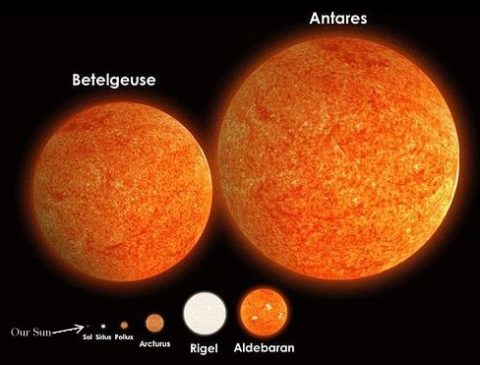 There was an ugly rumour that the giant red star, Betelgeuse, that is the right shoulder (on the left as you look at it) of the constellation Orion is “about to” go supernova. The rumours seemed to have started earlier in the year when observations suggested that Betelgeuse had changed shape, a sure sign of imminent explosion. Phil Plait apparently debunked the claims on his BadAstronomy blog.
There was an ugly rumour that the giant red star, Betelgeuse, that is the right shoulder (on the left as you look at it) of the constellation Orion is “about to” go supernova. The rumours seemed to have started earlier in the year when observations suggested that Betelgeuse had changed shape, a sure sign of imminent explosion. Phil Plait apparently debunked the claims on his BadAstronomy blog.
But what difference would it make to us if the star whose name is derived from the Arabic phrase “armpit of the white-belted sheep” were to explode? Could this be the worst case of Health and safety gone mad or a serious concern? Would we need sunglasses, tinfoil hat or simply resign ourselves to meeting ELE.
A physicist friend of mine suggested that Betelgeuse at (probably, about) 640 lightyears distance from earth is close enough that it going supernova would be an extinction-level event if there were a plume of gamma rays emitted in our direction. My son and his physics teacher disagree, suggesting that it’s too far away to cause anything but a bright light in the night, and perhaps daytime, sky.

Nathan Bergey was keen to point out that whether or not we should worry about a particular supernova really would depend on the distance, the type of supernova, and the direction of emissions. Wikipedia has its own interpretation, he pointed out and suggested that a 1 or 2 thousand parsecs (3000-6000 lightyears) might be a safe distance to be once the blue touchpaper were lit on any stellar neighbour.
According to a 2004 study, a gamma ray burst [from a supernova] at a distance of about 3,262 lightyears could destroy up to half of Earth’s ozone layer; the direct UV irradiation from the burst combined with additional solar UV radiation passing through the diminished ozone layer could then have potentially significant impacts on the food chain and potentially trigger a mass extinction. The authors estimate that one such burst might be expected every billion years or so.
My physicist friend points out that we could easily measure the neutrino flux from the 1987 supernova SN1987A, which is 170,000 lightyears away. Radiation intensity goes with distance squared so the radiation field from Betelgeuse would be 1000 times as intense as 1987A, “it would be fun, but probably not fatal,” he concedes. “A supernova at 50 lightyears would probably be more of an issue.”
One of the problems with supernova risk assessment is that we’re not entirely sure what lies between us and the putative fireball. If there are clouds of hydrogen and cosmic dust, then lethal gamma rays will tend to undergo Compton scattering at lower energies and form electron/positron pairs at higher enegies so the intesity will tend to dissipate as the rays travel through space.
In the 1950s, public information movies warned you to duck and cover when you saw the flash from a nuclear bomb. That was never going to save your skin, but nor was a tinfoil hat. Next time you’re musing on a starry, starry night just remember to keep a good pair of sunglasses handy alongside your telescope.